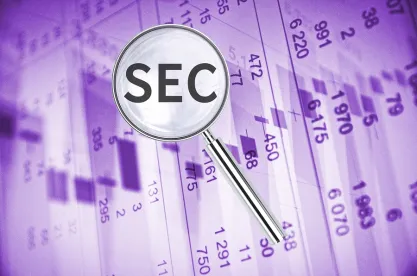The Securities and Exchange Commission (SEC) is poised to make good on its promise to ramp up enforcement efforts in relation to climate risk and environmental, social, and governance (ESG) disclosures. Last week, the SEC’s Division of Corporate Finance (Division) published a sample of a letter the agency may send to public companies asking for more information about climate change-related risks and ESG disclosures in their public filings. Earlier this year, in March 2021, the SEC announced that the agency had established an enforcement task force focused on identifying gaps in climate and ESG disclosures under existing requirements. In parallel, the SEC is considering new requirements to update those standards, which we now expect to occur in late 2021 or early 2022. Under Chair Gensler, public companies face increasing scrutiny at the SEC with respect to climate and ESG disclosures and should review their filings to ensure compliance.
Key Takeaways
-
As outlined in the SEC’s 2010 Climate Change Guidance, existing rules already require public companies to report on certain climate change matters and attendant material risks.
-
The Division reviews companies’ filings “to monitor and enhance compliance with applicable disclosure requirements.” However, the SEC has not historically taken significant enforcement action with respect to climate-related disclosures.
-
Following President Biden’s inauguration and the new administration’s “whole of government” approach to climate change, the SEC announced a new task force focused on scrutinizing and enforcing climate and ESG disclosure requirements.
-
In parallel, the SEC has collected comments on a range of climate and ESG disclosure matters and has announced its intent to issue new guidance or rules governing climate and ESG disclosures.
-
The new requirements, a draft of which is expected in late 2021 or early 2022, are widely expected to be more comprehensive and prescriptive than the 2010 Guidance.
-
In the meantime, the SEC’s enforcement task force has ramped up scrutiny of the current requirements.
-
Given this increased focus at the SEC, public companies should remain attuned to their disclosure obligations under existing SEC guidelines and begin preparing for a more robust disclosure environment in the future.
The SEC Sample Letter
As an apparent opening salvo, the Division published on its website a sample letter providing insight into the information SEC seeks. The Division characterized the letter as an “illustrative letter” with “sample comments” that the SEC may issue to companies regarding their climate disclosures (or absence thereof).
The sample letter appears to reflect an approach where the Division could ask companies to respond to the SEC’s comments and questions by either providing the requested information or updating their current public-facing disclosures, which typically are contained in the annual 10-K and other required filings submitted to the SEC. The 2010 Guidance identified four specific reporting requirements under Regulation S-K that may trigger reporting of material climate-related risks. The sample letter focused on two of those disclosure requirements, Risk Factors (Item 1A on Form 10-k; 17 C.F.R. § 229.105) and Management’s Discussion and Analysis of Financial Condition and Results of Operations (“MD&A”) (Item 7 on Form 10-K; 17 C.F.R. §229.303), and identified in the letter specific issues for increased focus and responsive action.
The sample letter also reflects what appear to be the Division’s more generalized observations regarding disclosures, and highlights that the SEC is comparing what filers are disclosing across different reporting mediums. For example, the sample letter indicates that the SEC remains concerned with disclosure gaps, i.e., scenarios in which companies provided more expansive disclosures in corporate social responsibility (CSR) reports than in SEC filings, and that the SEC is prepared to seek explanation of these gaps. Such inquiries appear likely to impact those companies that have announced significant voluntary greenhouse gas (GHG) reductions or other ESG initiatives that are not documented in annual reports or 10-K filings. It is worth noting that there is some potential disconnect here, since current SEC guidance focuses on the disclosure of material risks, as opposed to voluntary initiatives. Nonetheless, this line item highlights the SEC’s increasing focus on both risk items and ESG/GHG disclosures in general. It also may preview where the SEC is headed in the updated reporting requirements under development, which are likely to include expanded non-risk reporting elements.
With respect to Item 1A (Risk Factors), the Division’s sample letter focused on the different business risks associated with climate change, whether financial or operational. Example comments within the letter include:
-
Asking companies to disclose the material effects of transition risks related to climate change that may affect a company’s business, financial condition, and results of operations, such as policy and regulatory changes that could impose operational and compliance burdens, market trends that may alter business opportunities, credit risks, or technological changes.
-
Asking companies to disclose any material litigation risks related to climate change and to explain the potential impact to the company.
These items generally align with the current approach of the 2010 Guidance, but again highlight the SEC’s increased scrutiny in these areas.
The most detailed sample requests relate to disclosures provided pursuant to Item 7 (MD&A). Comments under this section include:
-
Highlighting omissions regarding discussion of significant developments in federal and state legislation, regulations, and international accords regarding climate change. Companies may be asked to revise their disclosures to identify material pending or existing climate change-related legislation, regulations, and international accords and describe any material effect on their business, financial condition, and results of operations.
-
Requesting that companies discuss, to the extent material, the indirect consequences of climate-related regulation or business trends, such as:
-
Decreased demand for goods or services that produce significant greenhouse gas emissions or are related to carbon-based energy sources;
-
Increased demand for goods that result in lower emissions than competing products; and
-
Increased competition to develop innovative new products that result in lower emissions.
-
-
Requesting that companies quantify any material increased compliance costs related to climate change.
-
Requesting that companies, if material, provide disclosures about its purchase or sale of carbon credits or offsets and any material effects on the business, financial condition, and results of operations.








 />i
/>i
